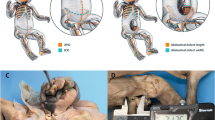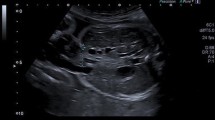Abstract
Objective
The objective of this study was to explore the localization of the pylorus, its macroscopic and microscopic development and relationship with neighboring structures.
Materials and methods
The study is carried out on 160 human fetuses aged between 9 and 40 weeks of gestation. Abdomen was divided into four quadrants by horizontal and vertical planes passing through the umbilicus. Topographical localization of the pylorus in reference to these quadrants and its distance were determined. Pylorus was divided into pre-pyloric, pyloric, and post-pyloric regions. Starting from the pre-pyloric end, serial sections spanning whole pyloric part were obtained. Wall thickness, the thickness of the muscular coat were measured under light microscope using sections stained with hematoxylin eosin. Sections with the thickest muscular coat were considered as the region where pyloric sphincter was.
Findings
Pylorus was located in the right upper quadrant, on the median plane and in the left upper quadrant. There was a significant relation between the thickness of the muscular coat in the stomach, duodenum and the pyloric region and gestational age. In the region of the pyloric sphincter, the rate of increase in the thickness of the muscular coat was higher in the first and the first half of the second trimesters than term fetuses.
Conclusion
We believe that data obtained in the present study will contribute to the assessment of development of the pyloric region in intra-uterine cases.




Similar content being viewed by others
References
Bannister LH (1995) Alimentary system. In: Gray’s anatomy, 38th edn. Churchill Livingstone Medical Division of Langman, London, pp 1795–1807
Blumhagen JD, Maclin L, Krauter D, Rosenbaum DM, Weinberger E (1998) Sonographic diagnosis of hypertrophic pyloric stenosis. AJR Am J Roentgenol 150(6):1367–1370
Bourdelat D, Barbet JP, Chevrel JP (1992) Fetal development of the pyloric muscle. Surg Radiol Anat 14(3):223–226
Cetin E, Malas MA, Albay S, Cankara N (2006) The development of stomach during the fetal period. Surg Radiol Anat 28(5):438–446
Cook RCM (1990) Gastric outlet obstruction. In: Lister J, Irving Irene M, Rickham PP (eds) Neonatal surgery, 3th edn. Butterworth, London, pp 403–408
Goldstein I, Reece EA, Yarkoni S, Wan M, Green JL, Hobbins JC (1987) Growth of the fetal stomach in normal pregnancies. Obstet Gynecol 70(4):641–644
Guarino N, Shima H, Puri P (2000) Structural immaturity of the pylorus muscle in infantile hypertrophic pyloric stenosis. Pediatr Surg Int 16(4):282–284
Henrich M (1986) Clinical anatomy of the pyloric region. Zentralbl Chir 111(9):518–525
Howard CV, Reed MG (1998) Unbiased stereology, three-dimensional measurement in microscopy. BIOS Scientific Publishers, Oxford, pp 39–68
Keet AD (1982) The anatomical extent of the pyloric sphincteric cylinder, the pyloric mucosal zone and the pyloric antrum. S Afr Med J 62(10):329–333
Kepkep K, Tuncay YA, Göynümer G, Yetim G (2005) Nomogram of the fetal gastric size development in normal pregnancy. J Perinat Med 33(4):336–339
Kobayashi H, O’Briain DS, Puri P (1994) Selective reduction in intramuscular nerve supporting cells in infantile hypertrophic pyloric stenosis. J Pediatr Surg 29(5):651–654
Malas MA, Aslankoç R, Ungör B, Sulak O, Candir O (2003) The development of jejunum and ileum during the fetal period. Early Hum Dev 74(2):109–124
Malas MA, Sulak O, Gökçimen A, Sari A (2004) Development of the vermiform appendix during the fetal period. Surg Radiol Anat 26(3):202–207
Moore KL, Persaud TVN (1998) The developing human (clinically oriented embryology), 6th edn, pp 109–110
O’Keeffe FN, Stansberry SD, Swischuk LE, Hayden CK Jr (1991) Antropyloric muscle thickness at US in infants: what is normal? Radiology 178(3):827–830
Oue T, Puri P (1999) Smooth muscle cell hypertrophy versus hyperplasia in infantile hypertrophic pyloric stenosis. Pediatr Res 45:853–857
Pilu G, Kypros N (2002) 18–23 week pregnancy ultrasound, prenatal diagnosis of fetal anomalies (translation). Ermiş H (ed) June, pp 67–75
Rohrschneider WK, Mittnacht H, Darge K, Tröger J (1998) Pyloric muscle in asymptomatic infants: sonographic evaluation and discrimination from idiopathic hypertrophic pyloric stenosis. Pediatr Radiol 28(6):429–434
Sase M, Asada H, Okuda M, Kato H (2002) Fetal gastric size in normal and abnormal pregnancies. Ultrasound Obstet Gynecol 19(5):467–470
Shima H, Ohshiro K, Puri P (2000) Increased local synthesis of epidermal growth factors in infantile hypertrophic pyloric stenosis. Pediatr Res 47(2):201–207
Spinelli C, Bertocchini A, Massimetti M, Ughi C (2003) Muscle thickness in infants hypertrophic pyloric stenosis. Pediatr Med Chir 25(2):148–150
Sadler TW (1995) Langman’s Medical embryology, 7th edn, Williams and Wilkins, Baltimore, pp 236–242
Vanderwinden JM, Liu H, De Laet MH, Vanderhaeghen JJ (1996) Study of the interstitial cells of cajal in infantile hypertrophic pyloric stenosis. Gastroenterology 111:279–288
Author information
Authors and Affiliations
Corresponding author
Rights and permissions
About this article
Cite this article
Koyuncu, E., Malas, M.A., Albay, S. et al. The development of fetal pylorus during the fetal period. Surg Radiol Anat 31, 335–341 (2009). https://doi.org/10.1007/s00276-008-0449-8
Received:
Accepted:
Published:
Issue Date:
DOI: https://doi.org/10.1007/s00276-008-0449-8




